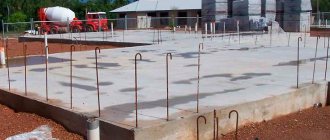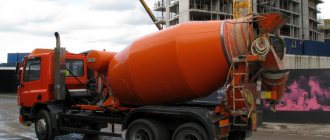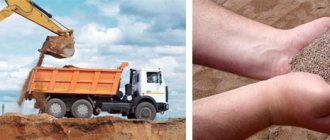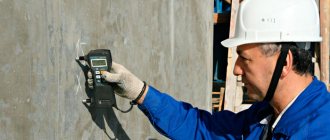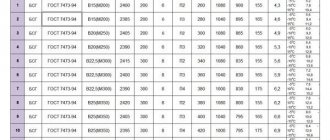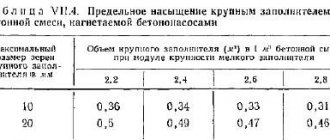Composition and organizational and technological implementation of the process
In general, the transport process includes receiving the mixture from the dispensing hopper of a concrete mixing plant, delivering (moving) it by various vehicles to the concreting object, then delivering the mixture to the place of placement or reloading it onto other vehicles or devices that deliver the mixture to the concreting unit.
A concreting block is a structure or part of it prepared for laying concrete with installed formwork and mounted reinforcement.
In practice, the process of delivering concrete mixture to a concreting block is carried out according to two schemes: from the place of preparation to the place of unloading directly into the concreting block, from the place of preparation to the place of unloading at the object being concreted and subsequent delivery to the concreting block. This scheme provides for intermediate reloading of the concrete mixture.
Transportation of the concrete mixture from the place of preparation to the place of unloading directly into the concreting block or at the concreting object is carried out mainly by road transport, and transportation from the unloading place at the concreting object to the concreting block is carried out by cranes (in buckets), lifts, conveyors, concrete spreaders, vibrating feeders, motorized carts, concrete pumps and pneumatic blowers. With this scheme, the productivity of the mechanisms for receiving and supplying concrete mixture to the concreting block should be 10... 15% higher than the productivity of the servicing set of vehicles in order to avoid their downtime during unloading.
When transporting a concrete mixture, the main technological condition is to maintain its homogeneity and ensure the mobility required for placement. To do this, the concrete mixture should not be exposed to precipitation or sunlight, it should not delaminate, cement laitance or mortar should not leak out of it, and in winter the concrete mixture should be protected from rapid cooling and freezing.
rules and methods of transportation or transportation
Transporting concrete is not as simple as it seems at first glance. For high-quality transportation of a solution of sand, cement, and water, some nuances are taken into account. For example, during transportation, the possibility of delamination of the transported material is taken into account, and the solution is protected from exposure to direct sunlight and precipitation. Organized transportation of concrete solution includes properly selected rolling stock, with the help of which the presentation properties of the transported cargo are preserved. To preserve the desired qualities of the concrete mixture, transportation is carried out without additional transfer points, and the transportation distance is also taken into account.
Transportation rules
When transporting concrete mortar, a number of rules are followed:
- When transporting concrete by any means of transport, its characteristics are taken into account.
- It is prohibited to transport cargo in bulk in on-board vehicles.
- When transporting a mixture of sand, water, cement, adhere to the permissible transportation time.
- For porous aggregates, the transportation time is taken into account; it should not exceed 50 minutes. If this is not possible, concrete mixers are used.
- The prepared concrete mixture is transported to the place of its installation, taking into account climatic conditions.
- The finished train is transported with a minimum number of transfer points.
Return to contents
Reasons for the decline in transportation quality
The concrete mixture must be delivered within 50 minutes.
In order for the concrete mixture to have a marketable appearance and meet the required quality, a number of circumstances are taken into account during transportation that will help reduce the risk of incorrect transportation:
- Concrete that is moved for 50 minutes or more without mixing with specialized mixers is subject to setting to the transported vehicle, which happens more often in the warm season.
- On bumpy roads, separation may occur when the mixture is moved. This phenomenon often occurs when transporting a solution of cement and water with incorrect proportions (the amount of water is higher than normal). In this case, the mixture must be transported by one vehicle without reloading points.
- A mixture of cement, water and sand that has delaminated as a result of transportation is prohibited for use for installation. You can save a heterogeneous mixture by mixing it thoroughly, as well as identifying and eliminating the reasons why the separation occurred.
Return to contents
Transportation methods
In the process of moving concrete, the distance of the construction site from the plant is taken into account, the type of structure, the presence of transport vehicles and the characteristics of the concrete mixture are taken into account. Transportation includes the following ordered processes:
- filling a vehicle with a mixture of concrete;
- direct transportation of concrete;
- reloading cargo into a wooden bucket or bunker;
- supplying a solution of sand, cement and water to the concreting site.
The costs of the transportation process are calculated based on the total cost of concrete and all costs of the business. The cost of transportation depends on the quality of the concrete mixture, which can deteriorate with numerous cargo overloads. Transportation is carried out in portions, continuously and combined. Thorough transportation is achieved using an automated control system. Transportation of concrete solution is carried out by a mixer and a dump truck.
Return to contents
Mixer
An effective way to transport a concrete mixture is to transport it with a mixer. The concrete mixer truck prevents the stratification of the transported material even when transporting it over long distances. Concrete that needs to be transported to a remote location is loaded into the ABS as a dry component. Water for diluting the material is located in a separate compartment of the vehicle. The concrete mixer truck has a number of advantages:
- When transported by this type of transport, delamination of the concrete material, as well as its setting and freezing, is excluded;
- the solution is transported in a dry composition;
- concrete conditions are created to protect it from the sun and precipitation.
Return to contents
Dump truck
A dump truck is used to transport the solution of water and cement. Its main advantage is the ability to transport large amounts of cargo. The disadvantages include the percentage of loss of mixture volume during transportation, since the dump truck body is not designed for transporting concrete composition. This happens due to insufficient tightness of the seams of the body, as well as due to the inability to maintain the required temperature of the cargo during the cold season. If overloading of the mixture by a dump truck is used, then its short range is taken into account.
Return to contents
Transportation methods
To complete the successful transportation process of concrete solution, the smallest number of transfer points is calculated. Based on the volume of work and the distance of the objects, a suitable vehicle is selected, and it is also taken into account that on uneven terrain the transported material is subject to delamination. Cranes, elevators, concrete spreaders, belt conveyors, and pipeline transport are used to move a mixture of cement, sand, and water from the unloading point to the concreting site.
Submission is carried out:
Return to contents
Cranes
Cranes are used to move concrete mortar from the unloading point to the required site. The mixture is delivered using conveyors, lifts and other auxiliary mechanisms. Concrete must be moved using high-performance cranes. This choice of mechanism will eliminate the downtime of vehicles during unloading.
Return to contents
Lifts
Lifts at construction sites are used for vertical movements of used materials, for example, when working with concrete mixture between floors of half-timbered buildings. The solution is raised to the desired height using buckets or containers.
Return to contents
Concrete pavers
This transport mechanism is used for solid foundations of buildings and structures; it is the best technology for these purposes. Concrete pavers are universal machines that are used for laying and leveling mixtures of cement, sand, and water during the construction of monolithic structures. Transportation in the concrete paver takes place using a telescopic belt conveyor. The height of the solution supplied by the mechanism is about 7-9 meters.
Return to contents
Belt conveyors
The process of supplying concrete with belt conveyors occurs as follows: a solution of water and cement is placed on a conveyor belt, which, in turn, smoothly and evenly transfers the mixture of the required thickness. To prevent the belt from becoming dirty, drums are used to clean it, which are equipped with conveyors. To prevent the mixture of sand, crushed stone, and water from separating when conveyed by conveyors, it is necessary to maintain a movement distance that does not exceed 6 cm.
Return to contents
Pipeline transport
In construction practice, pipeline transport is used to move a mixture of cement, sand, and water, which has the following advantages:
- Cargo transportation occurs in vertical and horizontal positions, with only one mechanism working;
- It is possible to transport concrete to inaccessible areas of a construction site.
Pipeline rolling stock includes equipment that is needed to distribute a mixture of sand, crushed stone, cement and water. The concrete mixture is supplied to the masonry site using a concrete pump in a vertical or horizontal direction. It is impossible to do without this type of equipment when raising concrete multi-story structures.
For the convenience of reloading a mixture of sand, cement, and water, automated control systems are used. The automated control system allows you to determine the exact schedule for the delivered material associated with the transportation of cargo. The main task of an automated control system is to increase the efficiency of a construction project by optimizing labor productivity and planning the management process.
kladembeton.ru
Transportation of concrete mixture by road
Automobile transportation of concrete mixture is carried out in dump trucks, concrete trucks, concrete mixer trucks, as well as containers or tubs installed in the bodies of on-board vehicles.
The volume of transportation of concrete mixture in dump trucks reaches 80%. Dump truck bodies are poorly suited for these purposes. As a result, 1...2% of the mixture is lost along the way (splashes out when driving on bad roads and when descending into pits, flows out into the cracks of the tailgate). When unloading the body, it is necessary to clean it manually; the concrete mixture in dump trucks delaminates, in the summer it loses water, and in the winter it quickly cools.
Modernization of dump truck bodies by extending the sides and installing sealing gaskets at the rear sides, although it reduces losses, does not solve the problem as a whole. Only the use of special concrete dump trucks ensures the delivery of high-quality concrete mixture to the site.
The body of the concrete truck has a mold-shaped (trough-shaped) shape without a tailgate. Smooth connections between the sides and the bottom eliminate concrete sticking in the corners. A fairly large tilt angle of the body (80°) and the presence of a vibration exciter allows you to quickly unload the mixture without manual labor. The lid protects the concrete mixture from water loss and cooling.
To transport concrete mixture in urban environments, as well as over long distances (up to 70 km), it is especially advisable to use concrete mixer trucks. Dry concrete mixture is loaded into the mixing drum at the concrete plant, and water is supplied before arriving at the site (or directly at the site). The finished mixture is unloaded by rotating the mixing drum in the opposite direction. The presence of a folding unloading tray allows for batch unloading, as well as feeding the mixture directly into the structure. The use of concrete mixer trucks makes it possible to significantly increase the permissible distances for transporting concrete mixtures without reducing their quality.
Transportation of concrete mixture by road in containers (or tubs) is rarely used due to underutilization of 20...30% of the carrying capacity of vehicles and the need to create a large revolving fleet of containers, which reduces the economic efficiency of this method.
The cost of transporting concrete mixture in concrete trucks and concrete mixer trucks is 10... 15% lower than in dump trucks, and therefore they should find primary use in modern construction.
The concrete mixture delivered to sites in dump trucks, fuel trucks or concrete mixer trucks is unloaded directly into the structure without additional overload or reloaded into intermediate containers for subsequent delivery to the concreting unit.
Direct supply of the mixture without overload is usually used when concreting structures located at ground level or low-volume buried structures. This is the simplest method that does not require any additional devices or accessories.
Laying of the concrete mixture in structures located in a pit (below ground level) is carried out with intermediate overload into a vibrating feeder and subsequent supply to the concreting block via vibrating chutes.
The vibratory feeder is a triangular welded box equipped with a vibrator. The vibratory feeder is installed so that its bottom is inclined 5... 10° towards the concrete structure. The outlet opening of the vibrating feeder is equipped with a sector gate.
Vibrating gutters 4 and 6 m long are attached to the exit opening. The gutters are attached to inventory racks using spring suspensions. The angle of inclination of the vibrating gutters to the horizon is 5...30°. Using vibrating gutters, mixtures with a cone draft of 4... 12 cm are laid.
Rigid mixtures do not move well along vibrating chutes, but cast mixtures can be transported along vibrating chutes with slight slopes (5... 10°). At large slopes, the concrete mixture splashes out over the sides of the vibrating chutes. The rate of laying using vibrating chutes depends on the angle of their inclination and the settlement of the concrete mixture cone. It ranges from 10 to 30 m3/h.
Supplying concrete mixture with cranes and lifts
Self-propelled tower and jib cranes with a set of buckets are used for batch supply and distribution of concrete mixture in concreting blocks. The mixture delivered by road is unloaded at the site into buckets and supplied directly to the structure by cranes. In this case, the concrete mixture moves both vertically and horizontally, which ensures its distribution during laying.
There are rotating and non-rotating tubs.
A rotary tub is a welded container consisting of a body, frame, shutter, and lever. Sometimes a vibrator is installed on the body of the tub. The frame is made in the form of a sled, the design of which allows the tub to be loaded in a horizontal position. When lifted by a crane, the tub is slung by the loops and it, smoothly rolling, takes a vertical position. In this position, the tub is moved and unloaded. When lowering the tub under loading, it smoothly assumes a horizontal position with the loading hole upward.
A fixed tub is also a welded container, but unlike a rotating one, it is loaded in a vertical position. Rotating buckets are primarily used; non-rotating buckets are used in cases where the concrete mixture needs to be supplied in small portions (into columns, walls of small thickness, etc.). Buckets are usually made with a capacity of 0.5...2 m3.
To move the concrete mixture only vertically, various lifts are used. Thus, when concreting the interfloor floors of frame buildings, post-type lifts are used, which lift the concrete mixture in buckets or containers. For horizontal transportation of the mixture, he uses wheelbarrows, rickshaws, scooters or motorized carts.
Transportation of concrete mixture by belt conveyors and concrete pavers
In industrial and civil construction, belt conveyors are used as intra-building transport for supplying concrete mixture, mainly when concreting structures with small dimensions in plan (point structures).
For the needs of builders, the industry produces mobile belt conveyors with a length of 6... 15 m and a width of a smooth or ribbed belt of 400... 500 mm. Such conveyors can deliver concrete mixture to a height of 1.5...4 m.
The main working part of the conveyor is a flexible rubberized belt that goes around the drive and tension drums and rests on supporting upper grooved roller bearings and lower flat roller bearings. The concrete mixture is loaded onto the belt through feeders, which allow the mixture to be continuously and evenly supplied to the required thickness.
The conveyor drums are equipped with devices that clean the belt from cement mortar and return it to the supplied concrete mixture.
To avoid stratification of the concrete mixture, its mobility when fed by conveyors should not exceed 6 cm. The angles of inclination of the conveyor when lifting the mixture with mobility up to 4 cm - up to 18°, 4... 6 cm - up to 15°, and when lowering the mixture - up to 12 and 10, respectively °. The belt speed should not exceed 1 m/s. When unloading from the conveyor, in order to avoid delamination, guide shields or a funnel with a height of at least 0.6 m are used. The installation of one-sided shields or canopies, as well as the free fall of the mixture from the conveyor, is not allowed.
Mobile belt conveyors, having high productivity (up to 35 m3/h), do not distribute the concrete mixture over the area of the concrete structure. Therefore, the conveyor has to be rearranged during the feeding process, which requires additional labor and causes delays in concreting.
More effective are concrete pavers, which are used to construct monolithic foundations for buildings and technological equipment, as well as other dispersed objects. A concrete paver is a self-propelled machine, on a rotating platform of which there is equipment for receiving concrete mixture and delivering it to the place of placement. The transporting element of the concrete paver is a telescopic belt conveyor, consisting of a main conveyor and a moving one. The concrete paver takes the concrete mixture from the body of the concrete truck into the bunker, from where it enters the main conveyor and then directly into the structure. Concrete mixture can be supplied to any point in the plan from 3 to 20 m with a boom rotation of up to 360° from one working position. The concrete paver can deliver the mixture to a height of 8 m, and also lower it below the parking lot with a conveyor slope of up to 10°.
What do you need to know about transporting ready-mixed concrete?
Question: How to properly transport concrete mix to the construction site? What nuances do you need to know in order to get a high-quality mixture for the object?
Proper transportation and unloading of ready-mixed concrete
During the construction of civil and industrial buildings (structures) located within large cities or in their suburbs, it is carried out using ready-mixed concrete, which is ordered from concrete manufacturing plants.
It is not effective to deliver concrete over long distances (more than 70 km), since its cost is very high due to long-distance delivery. Ready-mix concrete can be delivered to a construction site using dump trucks or concrete mixer trucks (popularly called “mixers”).
The main requirements for concrete during its transportation are to preserve its basic properties (design grade strength, mobility and homogeneity) and to prevent the mixture from separating.
Transporting a concrete mixture using a dump truck can be justified over short distances (maximum 15 km, taking into account the good quality of the road surface), since in this case, the concrete mixture often delaminates and requires additional mixing immediately before laying.
Delivery of concrete mix by concrete mixer trucks
Let's briefly look at what concrete mixer trucks are, photo 1.
As noted above, ready-mixed concrete is transported by concrete mixer trucks, which allow the basic properties of concrete to be preserved during its transportation. All concrete mixer trucks are made on the basis of KAMAZ, KRAZ, MERSEDEC, etc. trucks. The machines are equipped with a barrel-shaped container of various volumes, equipped inside with blades for mixing the concrete mixture using an engine.
Photo 1. Concrete mixer trucks
All concrete mixer trucks have their own classification based on the following criteria:
- drum drive type: mechanical or hydraulic;
- unloading directions: unloading “forward” or “backward”;
- mixer motor type: stand-alone and “engine on chassis”.
Advantages of delivering concrete by concrete mixer trucks
Using concrete mixer trucks to deliver concrete mixture has a number of advantages:
- the concrete mixture can be directly prepared in concrete mixer trucks while on the way to the construction site (a dry mixture of all concrete components is loaded into the drum, and then, when approaching the construction site, the required amount of water is added and a “fresh” concrete mixture is prepared by mixing). This method increases the time to ensure the mobility of the concrete mixture and the permissible transportation distance (100...200 km);
- ensures the homogeneity of the concrete mixture and prevents it from separating;
- protects the concrete mixture from atmospheric influences: sunlight, wind, precipitation, etc.;
- the volume of concrete mixture that can be transported using one concrete mixer truck is 3...12 m3;
- Some concrete mixer trucks are equipped with an additional unloading pipe up to 8 meters long, which allows you to unload concrete mixture in hard-to-reach places.
Depending on the type of concrete mixture and ambient air temperature, the duration of transportation should not exceed 45 minutes, and for some concretes up to 1.5 hours. After this time, the concrete begins to set, which leads to the impossibility of normal laying and a significant decrease in the strength of the concrete. Concrete mixer trucks are capable of operating at temperatures from 0○C to +40○C, and some types even at temperatures from –17○C.
Unloading concrete mixture
The concrete mixture can be supplied to the concreting site in different ways, and this depends on the type of structure, its height relative to ground level, the properties of the concrete mixture and the volume of work performed. Unloading concrete at a construction site can be done in several ways:
- If a specific object or concreting element is located in such a place that a concrete mixer truck can easily drive up, then unloading can occur directly from the mixer into trays, photo 2.
Photo 2. Unloading concrete mixture directly from a concrete mixer truck
- If a construction site or concreting element is located in a place that is difficult to reach for a mixer, then the concrete mixture is reloaded from a concrete mixer truck into a bucket or concrete pump, and then supplied to the specified location, photos 3 and 4.
Photo 3. Buckets for supplying concrete mixture and concreting
Photo 4. Concrete pumps
Also, when the concreting object is below ground level (pit), then first there is a reloading into a bucket, and then through a vibrating chute directly into the concreting block. If the concreting unit is at a height, the concrete is unloaded into a bucket and then transported to the desired location using cranes. The tub is filled to 0.9…0.95% of the total volume. The capacity of the tub can usually be as follows: 0.3; 0.6; 0.8; 1.0 m3.
- Supplying concrete mixture using concrete spreaders is effectively used for monolithic construction of small-sized foundations. Concrete pavers are self-propelled machines that take on concrete mixture and deliver it to the right place in the right quantity, photo 5.
Photo 5. Concrete pavers
When unloading concrete, the following requirements must be adhered to:
- It is allowed to throw the concrete mixture from a height of no more than 2 m, otherwise there is a high probability of separation of the mixture (heavy crushed stone falls down, and lighter cement mortar rises up).
- If it is necessary to supply concrete mixture to a depth of 10 m, vertical link trunks should be used, and if more than 10 m, vibrating trunks should be used.
- If it is necessary to supply concrete mixture to a height, cranes are used using buckets or rotary buckets. The maximum height of unloading a bucket with free fall of the concrete mixture to the surface should not exceed 1 m.
- For large volumes, it is more advisable to use concrete pumps or pneumatic conveying equipment, photo 6. A pneumatic conveying unit allows you to supply concrete under pressure up to 200 m horizontally and up to 35 m vertically, the productivity is 10...20 m3/h.
Photo 6. Pneumatic conveying installation for supplying concrete mixture
How to order concrete for construction?
When ordering ready-mixed concrete, you must follow the following recommendations:
- It is necessary to order concrete only from reliable, trusted manufacturers. In this case, the rule almost always applies: “The miser pays dearly.” In this regard, we recommend that you explore online construction forums in your region to search for reviews about concrete manufacturers.
- It is necessary to precisely agree with the manufacturer, based on the design documentation, what properties the required concrete should have (type of concrete, design strength, mobility or rigidity of the concrete mixture, speed of strength gain, if necessary, grade for frost resistance or water permeability, presence of antifreeze additives, etc.) .
- Check the volume and dimensions of the concrete mixer truck and check whether the mixer can be driven directly to the required location on the construction site. It is imperative to take into account the weight of the mixer with concrete mixture (can reach up to 35 tons) when driving and maneuvering on a construction site (this is especially dangerous near pits and trenches).
- It is imperative to request a concrete passport from the manufacturer, which indicates the main characteristics and volume of the concrete mixture.
- To avoid troubles, additionally calculate for yourself the approximate duration of delivery from the manufacturer to the site, taking into account traffic jams and the rush hour period.
- It is necessary to carefully prepare for unloading and laying the concrete mixture, because Manufacturers give 30...60 minutes to unload the mixer, and require additional payment for downtime and overtime.
And finally, we present a table from GOST 7473-94 “Concrete mixtures. Technical conditions" for the maximum duration of transportation of concrete mixture, table. 1.
Proper transportation of concrete mixture
The maximum permissible duration of transportation of ready-to-use concrete mixtures at air temperatures from 20°C to 30°C (at a mixture temperature of 18-20°C)
| Mixture grade according to workability | Type of road surface | Average transportation speed, km/h | Duration of transportation, min | |
| concrete mixer | dump truck | |||
| Zh2-Zh1 | Hard | 30 | 210 | 60 |
| P1 | Asphalt cement, asphalt concrete, concrete | 210 | 60 | |
| P2 | 150 | 40 | ||
| P3-P5 | 90 | 30 | ||
| Zh2-Zh1 | Soft (ground) | 15 | 60 | 40 |
| P1 | 45 | 30 | ||
| P2 | 30 | 20 | ||
| P3-P5 | 20 | Not recommended | ||
| Note - When the temperature of the mixture or the environment changes, the maximum permissible duration of transportation is determined experimentally. At ambient temperatures from 6 to 20°C and from –5 to +5°C, the transportation time of concrete mixtures can be increased by 10 and 25%, respectively. |
The author of the publication is an expert from GIDproekt
Konev Alexander Anatolievich
gidproekt.com
